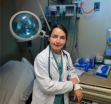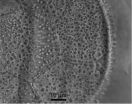(Press-News.org) Alexandria, VA — Patients with head and neck cancer receiving radiation treatment at an academic center have a higher survival rate than those receiving treatment at a community center, according to a study in the December 2012 issue of Otolaryngology–Head and Neck Surgery.
"Despite similar rates of treatment completion and rate of treatment breaks between groups, patients treated in academic centers had more advanced cancer but better survival," the authors state in their conclusion.
The study evaluated differences in patient characteristics, treatment, and cancer outcomes in the head and neck cancer population at the University of Minnesota from 2002 through 2008. Data were gathered on demographics, general medical data, tumor variables, insurance type, marital status and health behaviors.
The study analyzed 355 patients with mucosal head and neck cancer treated with radiation therapy from 2002 to 2008. One hundred forty-five (41%) received radiation treatment at community hospitals, and 210 (59%) were treated at academic hospitals. Within the academic hospitals group, 197 underwent radiation at the University of Minnesota, and 13 received radiation at an alternative academic center.
Both treatment groups shared similar characteristics in regard to sex, comorbidity, marital status, work status, insurance, and alcohol use. However, the community group had more current smokers and slightly older patients on average. Patients in the academic group were more likely to live in an urban location and had a higher median income. Patients undergoing radiation treatment at university centers had significantly more advanced cancer. After adjusting for these differences in patient characteristics, patients in the academic hospitals had about two-thirds the risk of dying compared with the community hospitals. The five-year survival rate was 53 percent for patients treated in academic centers compared with 33 percent for patients treated in community settings.
As a result of the study, the authors conclude that "more subtle differences in treatment administration and support at academic centers need to be investigated to understand the survival differences." In addition, the authors note, "Potential disparities in care related to income, socioeconomic status, and geography should be further explored."
###Otolaryngology–Head and Neck Surgery is the official scientific journal of the American Academy of Otolaryngology—Head and Neck Surgery Foundation (AAO-HNSF). The study's authors are Amy Anne D. Lassig, MD; Anne M. Joseph, MD, MPH; Bruce R. Lindgren, MS; Patricia Fernandes, DDS; Sarah Cooper; Chelsea Schotzko; Samir Khariwala, MD; Margaret Reynolds, MD and Bevan Yueh, MD, MPH.
Reporters who wish to obtain a copy of the study, "The Effect of Treating Institution on Outcomes in Head and Neck Cancer" should contact Mary Stewart at 1-703-535-3762, or newsroom@entnet.org.
About the AAO-HNS
The American Academy of Otolaryngology—Head and Neck Surgery (www.entnet.org), one of the oldest medical associations in the nation, represents nearly 12,000 physicians and allied health professionals who specialize in the diagnosis and treatment of disorders of the ears, nose, throat, and related structures of the head and neck. The Academy serves its members by facilitating the advancement of the science and art of medicine related to otolaryngology and by representing the specialty in governmental and socioeconomic issues. The organization's vision: "Empowering otolaryngologist-head and neck surgeons to deliver the best patient care."
The effect of treating institution on outcomes in head and neck cancer
2012-12-07
ELSE PRESS RELEASES FROM THIS DATE:
Point of light
2012-12-07
PASADENA, Calif.—As technology advances, it tends to shrink. From cell phones to laptops—powered by increasingly faster and tinier processors—everything is getting thinner and sleeker. And now light beams are getting smaller, too.
Engineers at the California Institute of Technology (Caltech) have created a device that can focus light into a point just a few nanometers (billionths of a meter) across—an achievement they say may lead to next-generation applications in computing, communications, and imaging.
Because light can carry greater amounts of data more efficiently ...
How the common 'cat parasite' gets into the brain
2012-12-07
"We believe that this knowledge may be important for the further understanding of complex interactions in some major public health issues, that modern science still hasn't been able to explain fully", says Antonio Barragan, researcher at the Center for Infectious Medicine at Karolinska Institutet and the Swedish Institute for Communicable Disease Control. "At the same time, it's important to emphasize that humans have lived with this parasite for many millennia, so today's carriers of Toxoplasma need not be particularly worried".
The current study, which is published ...
Putting electronic cigarettes to the test
2012-12-07
Electronic cigarettes are experiencing somewhat of a boom at the moment. An estimated two million people in Germany have already turned to the vapor cigarette, which many view as a healthy alternative to conventional smoking. However, a number of voices, primarily from the political sphere, are warning of possible health risks, claiming that the long-term consequences cannot yet be foreseen. Studies to date have come to mixed conclusions. There is a general lack of substantiated facts, fuelling an ongoing battle between supporters and opponents. By carrying out a new, independent ...
Group interaction among elderly is the key to significant health outcomes
2012-12-07
The health benefits of 'water clubs' in care homes for the elderly, where residents gather together regularly to drink water , owe as least as much to the social nature of the activity as to the value of drinking water itself, an investigation by psychologists has shown.
The study, funded by the Economic and Social Research Council (ESRC), supports other findings that interventions aimed at improving individuals' wellbeing and quality of life can be far more effective if they are carried out among groups of people in ways that generate a strong sense of group identity.
A ...
X-ray vision can reveal the moment of birth of violent supernovae
2012-12-07
A team of astronomers led by the University of Leicester has uncovered new evidence that suggests that X-ray detectors in space could be the first to witness new supernovae that signal the death of massive stars.
Astronomers have measured an excess of X-ray radiation in the first few minutes of collapsing massive stars, which may be the signature of the supernova shock wave first escaping from the star.
The findings have come as a surprise to Dr Rhaana Starling, of the University of Leicester Department of Physics and Astronomy whose research is published in the ...
Winning the battle against leukaemia: Positive early results in clinical trial for DNA vaccine
2012-12-07
Early results of a trial to treat leukaemia with a WT1 DNA vaccine, has shown robust vaccine-specific antibody responses in all vaccinated patients evaluated to date.
Furthermore, T cell immune responses, including those of the "killer T cells," were detected. Antibody and T cell responses are strong signals of the DNA vaccine's potential to treat the disease.
Presented at the DNA Vaccines 2012 conference in California by Christian Ottensmeier, the trial's principal investigator and Professor of Experimental Cancer Research at the University of Southampton, these interim ...
Rilpivirine for HIV: Added benefit for single agent proven
2012-12-07
Since the start of 2012, a new drug called rilpivirine has been available for adult patients infected with the human immunodeficiency virus type 1 (HIV-1). It is marketed by two different pharmaceutical companies, by one as a single agent (trade name Edurant®) and by the other as a fixed combination with other HIV drugs (trade name Eviplera®). In two early benefit assessments pursuant to the "Act on the Reform of the Market for Medicinal Products" (AMNOG), the Institute for Quality and Efficiency in Health Care (IQWiG) has investigated whether the two new drugs have advantages ...
High hormone levels put young black males at risk for cardiovascular disease
2012-12-07
AUGUSTA, Ga. – Increased levels of the hormone aldosterone in young black males correlate with an unhealthy chain of events that starts with retaining too much salt and results in an enlarged heart muscle, researchers say.
The findings indicate physicians may want to reach for aldosterone inhibitors early in their effort to control blood pressure and reduce cardiovascular risk in young black males.
Their studies of a cohort of 191 healthy black and white 15- to 19-year-olds showed that only in the black males was higher aldosterone associated with impaired sodium excretion, ...
A pattern given by nature
2012-12-07
A new plant-parasitic nematode worm (Meloidoderita salina) was found in a tidal salt marsh at Mont Saint Michel Bay (MSMB) in France, where its abbey is a world-famous historical heritage. The species name 'salina' refers to salty soil and is derived from the Latin word 'sal' or 'salis' meaning 'salt'. The study was published in the peer-reviewed, open source scientific journal ZooKeys.
The female nematode worm of Meloidoderita salina deposits its eggs in two different structures. One of them is called egg mass which is an external gelatinous matrix, the other one is ...
Monkey business: What howler monkeys can tell us about the role of interbreeding in human evolution
2012-12-07
ANN ARBOR—Did different species of early humans interbreed and produce offspring of mixed ancestry?
Recent genetic studies suggest that Neanderthals may have bred with anatomically modern humans tens of thousands of years ago in the Middle East, contributing to the modern human gene pool. But the findings are not universally accepted, and the fossil record has not helped to clarify the role of interbreeding, which is also known as hybridization.
Now a University of Michigan-led study of interbreeding between two species of modern-day howler monkeys in Mexico is shedding ...



